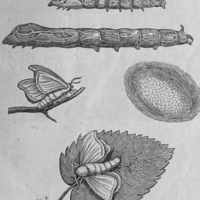Silkworm
Dublin Core
Title
Subject
Description
The silkworm was domesticated in China by 3000 BCE, and silk became a major trade good between Xi’an in central China and the eastern Mediterranean, carried by caravans across ancient routes that span the Taklamakan Desert. Known as the Silk Road, this route was established during the period of the Roman Empire. The smuggling of silkworms from China to Central Asia has been recorded since the second century BCE.
Silk manufacturing was widely spread throughout India, Persia, Arabia, and Europe. According to the romanticized account by Greek scholar Procopius (ca. 500–565), the knowledge of silkworm cultivation was kept a secret by the Chinese for a long time until silkworm eggs were “stolen” by certain Indian monks induced by Justinian Augustus in the sixth century CE. After they brought the eggs and the method of silk production to Byzantium, silk making began in the Roman empire. It is unknown how factual this version is or whether it is purely legend.
During the medieval period and the Renaissance, silk remained a luxury material in Europe, and its production was dominated by Italian merchants. Sericulture was introduced into Spain, Sicily, and Calabria as part of the Islamicate empire. In the eleventh century, Jewish artisans introduced the technique of silk-weaving to central Italy. In the early 1200s, it was estimated that skilled Greek and Muslim captives brought the techniques of silk-weaving to Venice, Milan, and Genoa. Throughout the thirteenth century, silk-weaving was established in Bologna, Florence, Pisa, and Arezzo. In the fourteenth century, during the exile of silk workers in the wake of political factionalism, the technique was carried over the Alps to France and Germany. By the fifteenth century, sericulture was practiced in southern France. Tours was the first city in France to have established a sizable silk production industry. In the seventeenth century, then superintendent of finance Jean-Baptiste Colbert launched an ambitious scheme to promote textile industries both inside France and in its colonies. Lyon later became France’s largest city of silk production.
Source
Fol. 52r - "The work done in Algiers"
…Around the feast of St. John, put into it a dozen & a half chicken eggs, that is to say, the yolk without the glair & the (germ) see). Others say lx yolks. And with this dozen & a half egg yolks put in half an ounce (others say for lx eggs half a lb) of female silkworm seeds. And after having luted the mattras well (I do not know if it is at all necessary for the generation that there be air), put it & bury it in the heat of the dung up to the neck, and leave it there until several worms are engendered…
Folio 53v-54r - “Silkworms”
They are produced from seed, that is to say eggs, that which is sold by the ounce, which is commonly sold in Languedoc iii lb v s. The one from Spain that merchants bring there is considered the best because the worms which come from there are not so subject to illnesses & make more silk. In Spain, from one ounce of seed, worms are produced from it which commonly yield xv lb of silk. But from one ounce of seed produced in France, only x or xii come out of it…
Contributor
G. S. Boulger, The History of Silk (London: East & West, 1920), http://hdl.handle.net/2027/njp.32101043323359.
Helen Saberi, “Silkworm,” ed. Alan Davidson and Tom Jaine, The Oxford Companion to Food (2 ed.) (Oxford University Press, 2013), https://www.oxfordreference.com/view/10.1093/acref/9780192806819.001.0001/acref-9780192806819-e-2236?rskey=gZgc8F&result=4.
Roy C. Cave and Herbert H. Coulson, A Source Book for Medieval Economic History (The Bruce Publishing Company, 1936), Access provided by HathiTrust Digital Library, https://babel.hathitrust.org/cgi/pt?id=uiug.30112051326327&view=1up&seq=11&skin=2021.
“Silkworm,” World Encyclopedia (Philip's, 2014), https://www.oxfordreference.com/view/10.1093/acref/9780199546091.001.0001/acref-9780199546091-e-10662?rskey=gZgc8F&result=2.
Melinda Watt, “Textile Production in Europe: Silk, 1600–1800,” in Heilbrunn Timeline of Art History (The Metropolitan Museum of Art, 2003) https://www.metmuseum.org/toah/hd/txt_s/hd_txt_s.htm.
Sasha Grafit, “Silkworms and the Work of Algiers,” in Secrets of Craft and Nature in Renaissance France. A Digital Critical Edition and English Translation of BnF Ms. Fr. 640, ed. Making and Knowing Project, Pamela H. Smith, Naomi Rosenkranz, Tianna Helena Uchacz, Tillmann Taape, Clément Godbarge, Sophie Pitman, Jenny Boulboullé, Joel Klein, Donna Bilak, Marc Smith, and Terry Catapano (New York: Making and Knowing Project, 2020), https://edition640.makingandknowing.org/#/essays/ann_059_sp_17. DOI: https://www.doi.org/10.7916/adew-hy48.
Image: “Silkworm.” American Antiquarian Society (AAS) Historical Periodicals, Vol. 1 Issue 1, Albany, N. Y., 1835. Access provided by Columbia University Library. https://search.ebscohost.com/login.aspx?direct=true&db=h9i&AN=47735626&site=ehost-live&scope=site.
Elia Zhang, Columbia University
